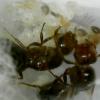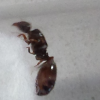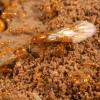I've tried a small colony of S. molesta with a relatively large colony of T. sessile ( I think). After a month the T. sessile colony was minus most of it's workers (100-200ish), but the molesta were doing very well.
For the first few weeks it seemed like the sessile were holding their own really well and seemed to dominate food sources I introduced, but finally I started noticing a lot less workers in the sessile colony and then it turned into a perpetual siege where the molesta would try and get into the tube that the sessile were living in at all times, while the sessile workers failed to prevent it.
The sessile workers had over the course of months piled all the gravel they had at the entrance of their 30x300mm test tube (it was really impressive considering how small the ants were) and the remaining entrance was only large enough for a few workers to fit through at a time. I actually saw a molesta worker push herself inbetween the gravel near the top and the glass and then propel herself through the gravel into the sessile nest before running back out the entrance. I eventually had to remove the molesta colony to preserve the sessile colony.
What I found most confusing about this is that it's not too uncommon here to dig up a sessile colony in spring and occasionally find a molesta colony nested in a tiny chamber right in the middle of the sessile colony. So I don't know why the sessile ants were unable to defend themselves against the molesta like they seemingly can in the wild.
Note that while I'm quite sure on the ID of the S. molesta, I'm not 100% on the ID of the T. sessile, but I expect a similar thing to occur with S. molesta and any other similarly sized ant.
Edited by Reacker, September 13 2015 - 8:01 AM.
![]()























